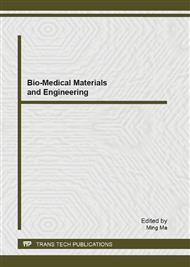p.3
p.13
p.18
p.23
p.27
p.31
p.38
p.44
Orthogonal Design Study on the Morphology of Electrospun Poly(butylene Succinate-co-Butylene Terephthalate) (PBST) Nanofibers
Abstract:
A biodegradable co-polymer, Poly (butylene succinate-co-butyene terephthalate) (PBST) was fabricated into nanofibers by electrospinning. A 4-factor 3-level L 9(34) orthogonal experimental design was employed to examine the effects of process parameters on morphologies of PBST nanofibers. The results showed that the weight concentration = 13wt%, the applied voltage = 20kV, the spinning speed = 0.5ml/h, the electrode distance = 10cm and the diameter of needle = 0.7mm were identified as the optimum conditions.
Info:
Periodical:
Pages:
23-26
Citation:
Online since:
August 2013
Authors:
Keywords:
Price:
Сopyright:
© 2013 Trans Tech Publications Ltd. All Rights Reserved
Share:
Citation:


